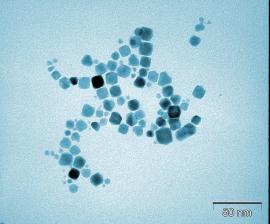Can we help you?
Contact us

Can we help you?
Contact us

Thank you for contacting us
Your form has been submitted successfully Our team will contact you again as soon as possible.
Whooppss...!! An error has occurred
Try sending later or write an email directly to areaempresas@ua.es

INFO
SHEET
DOWNLOAD
EXECUTIVE
ABSTRACT
CONTACT DETAILS: Research Results Transfer Office-OTRI
University of Alicante
Tel.: +34 96 590 99 59
Email: areaempresas@ua.es
http://innoua.ua.es
The group of Applied Electrochemistry and Electrocatalysis of the University of Alicante has adquiered an important experience and know-how in synthesizing different types of nanoparticles. The synthesis of the nanoparticles can be carried out using different methods, thus allowing to produce nanoparticles with controlled size, shape and atomic composition. These nanoparticles have a wide number of applications including, fuel cells, heterogeneous catalysts, electrocatalysts, pigments, nanomedicine, etc. In addition, the different nanoparticles can be also dispersed in different supports (carbón based materials, titania, ceria, etc). Consequently, on-demand nanomaterials can be produced for the costumers.

1. Synthesis of nanoparticles in microemulsion:
The use of water-in-oil microemulsions for the synthesis of nanoparticles is one of the most promising methods. The application of this technology allows the preparation of the nanoparticles. The microemulsion technology has been applied for the synthesis of pure metal nanoparticles (Pt, Pd, Ir, Rh, Rh, Au, Ag, Cu) as well as for the preparation of the bimetallic nanoparticles (Pt/Pd, Pt/Ru, Pt/Ir, Pt/Rh). The method can also be used for the synthesis of multimetallic nanoparticles. In the case of bi and multimetallic nanoparticles the atomic composition can be modified according with the needs.
Moreover, this methodology can be used for the preparation of different types of nanoparticles such as SiO2, CdS, ZnS, ZrO2, CaCO3, BaCO3, CdSe, TiO2, etc. The particle size of the nanoparticle ranges between 1-50 nm but is strongly dependent of the surfactant employed. The main advantage of this method is the different compositions and sizes that can be obtained.
The catalytic and electrocatalytic properties of the nanoparticles depend on the state and cleanness of their surface. For that reason is very important to develop some decontamination procedures able to clean the surface of the nanoparticles without modifying the initial structure and surface composition of the nanoparticles. This decontamination will allow the application of the nanoparticles with their complete catalytic or electrocatalytic properties. In the Institute of Electrochemistry some decontamination protocols able to obtain these requirements have been developed.
2. Synthesis of nanoparticles in colloidal systems:
The preparation of nanoparticles in colloidal systems is one of the most well known methods for the synthesis of nanomaterials. Moreover, this methodology allows, in several cases, synthesize nanoparticles with some preferential orientations/shapes and it is very well-known that the shape of the nanoparticles influences their optical, electronic, catalytic and electrocatalytic properties. This fact is specially important when the nanoparticles are going to be applied in electrocatalytic or catalytic reactions which are sensitive to the structure of the catalyst. The application of this method to electrocatalysis is a really innovative concept. Very remarkably, shape controlled nanoparticles are being currently used in medical applications (nanomedicine), due to their unique properties, for instance in cancer detection and treatment.
The particle size of the nanoparticle ranges between 5-50 nm but again is strongly dependent of the capping material employed. Thus, different shapes, with different properties, can be prepared (cubic, tetrahedral, spherical, truncated octahedral). Using this methodology, shape-controlled Pt nanoparticles have been prepared. As an example the following pictures are presented:

Similarly, shape-controlled Au nanoparticles can be prepared: 





And also for the synthesis of shape-controlled Pd nanoparticles:


In addition, these shape-controlled nanoparticles can be dispersed in different supports (carbon based materials, titania, etc…). Some examples of supported nanoparticles can be found in the following gallery of images: 



MAIN ADVANTAGES
• Customization of the process of synthesis, test, scale-up and technology transfer to the company.
• Use of decontaminated protocols for the cleaning of some particles.
• Techniques appropriated for metallic, bimetallic and multimetallic particles. Also applyable to other compounds as SiO2, CdS, ZnS, ZrO2, CaCO3, BaCO3, CdSe, TiO2, etc.
INNOVATIVE ASPECTS
• Possibilities of developing synthesis processes under customer’s requirements (sizes / shapes / composition).
• Electrocatalytic properties of nanoparticles are improved as a function of the size, and atomic composition of the nanoparticles.
• Synthesis of new catalyst and electrocatalyst by preferential surface structure / shapes (cubic, tetrahedral, spherical, octahedral, etc).
The use of nanoparticles could be of interest to:
• Optical, magnetic, catalytic and electrocatalytic properties.
• Sensors.
• Catalysts (supported and unsupported) for batteries, fuel cells, gas diffusion electrodes, etc.
• Ceramic materials.
• Pigments.
• Biological and medical applications.
Manufacturers of optical, magnetic, sensors, medical devices, catalysts (for using in batteries, fuel cells, gas diffusion electrodes, etc.), ceramic materials and/or pigments are sought in order to achieve technical cooperation and/or commercial with technical assistance agreements.
In case of technical cooperation: adapting or developing the technology for the sector or market in which the company could be involved and under their requirements.
In case of commercial agreement with technical assistance: training/assisting in set up processes, consulting in new processes, technical training.
In the following link you will find a description of the nature and activities of the Research Group:
https://cvnet.cpd.ua.es/curriculum-breve/grp/en/electroquimica-aplicada-y-electrocatalisis/356
Chemical Technology
Carretera San Vicente del Raspeig s/n - 03690 San Vicente del Raspeig - Alicante
Tel.: (+34) 965 90 9959




